Project Management Fundamentals: Assessment Task 1 Written Questions
VerifiedAdded on 2022/08/25
|11
|3541
|31
Homework Assignment
AI Summary
This document contains the solutions to Assessment Task 1, a written question-based assignment in Project Management. The questions cover various aspects of project management, including cost estimation tools (analogous, parametric, and three-point estimation), critical path analysis, Gantt charts, work breakdown structure, and project methodologies (Agile, Scrum, Waterfall, and Hybrid). The answers provide detailed explanations of each concept, its purpose, and its application in ICT projects. The assignment also requires paraphrasing the 12 principles of Agile methodology. The solutions aim to provide a comprehensive understanding of project management principles and their practical application.
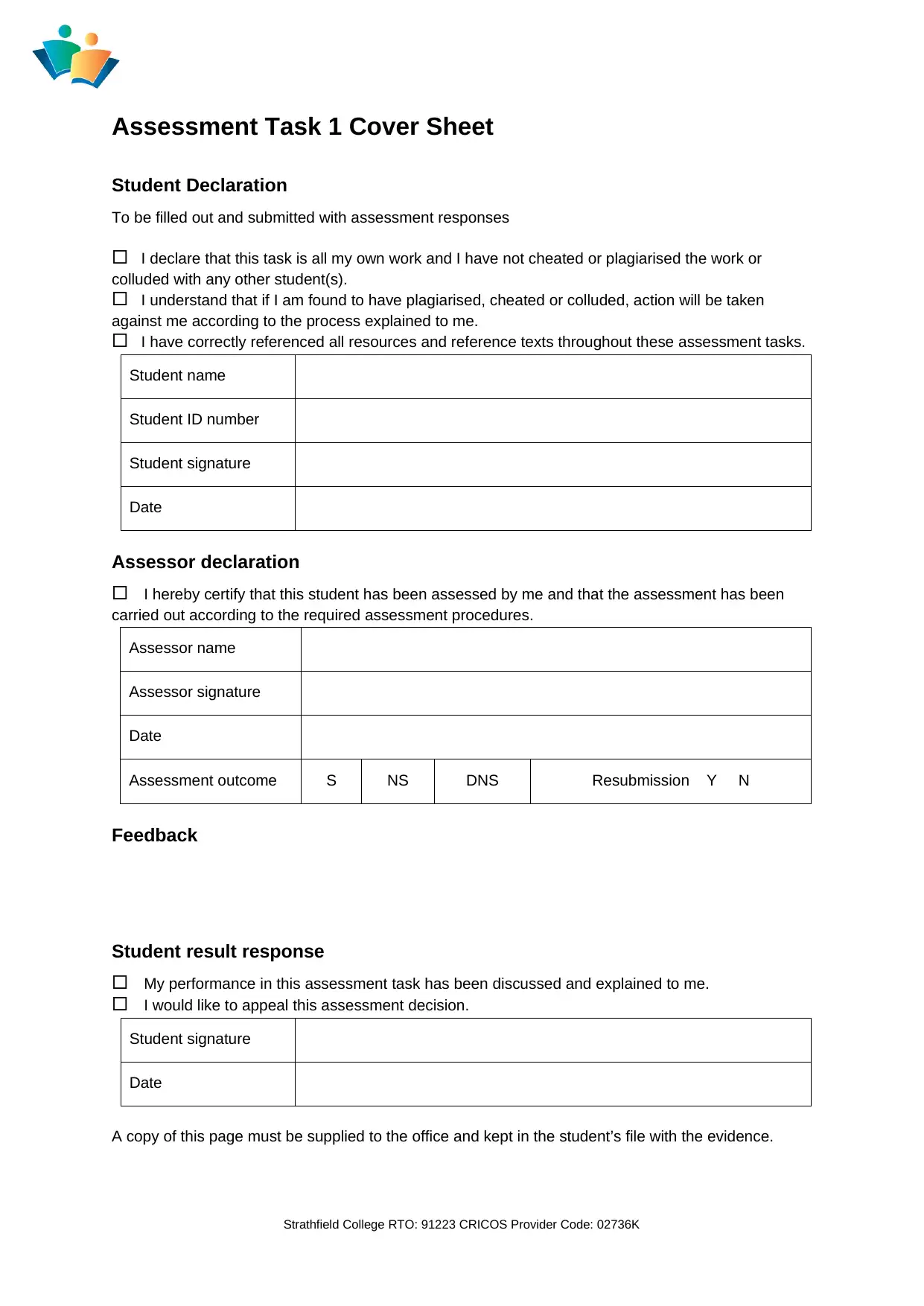
Assessment Task 1 Cover Sheet
Student Declaration
To be filled out and submitted with assessment responses
I declare that this task is all my own work and I have not cheated or plagiarised the work or
colluded with any other student(s).
I understand that if I am found to have plagiarised, cheated or colluded, action will be taken
against me according to the process explained to me.
I have correctly referenced all resources and reference texts throughout these assessment tasks.
Student name
Student ID number
Student signature
Date
Assessor declaration
I hereby certify that this student has been assessed by me and that the assessment has been
carried out according to the required assessment procedures.
Assessor name
Assessor signature
Date
Assessment outcome S NS DNS Resubmission Y N
Feedback
Student result response
My performance in this assessment task has been discussed and explained to me.
I would like to appeal this assessment decision.
Student signature
Date
A copy of this page must be supplied to the office and kept in the student’s file with the evidence.
Strathfield College RTO: 91223 CRICOS Provider Code: 02736K
Student Declaration
To be filled out and submitted with assessment responses
I declare that this task is all my own work and I have not cheated or plagiarised the work or
colluded with any other student(s).
I understand that if I am found to have plagiarised, cheated or colluded, action will be taken
against me according to the process explained to me.
I have correctly referenced all resources and reference texts throughout these assessment tasks.
Student name
Student ID number
Student signature
Date
Assessor declaration
I hereby certify that this student has been assessed by me and that the assessment has been
carried out according to the required assessment procedures.
Assessor name
Assessor signature
Date
Assessment outcome S NS DNS Resubmission Y N
Feedback
Student result response
My performance in this assessment task has been discussed and explained to me.
I would like to appeal this assessment decision.
Student signature
Date
A copy of this page must be supplied to the office and kept in the student’s file with the evidence.
Strathfield College RTO: 91223 CRICOS Provider Code: 02736K
Paraphrase This Document
Need a fresh take? Get an instant paraphrase of this document with our AI Paraphraser
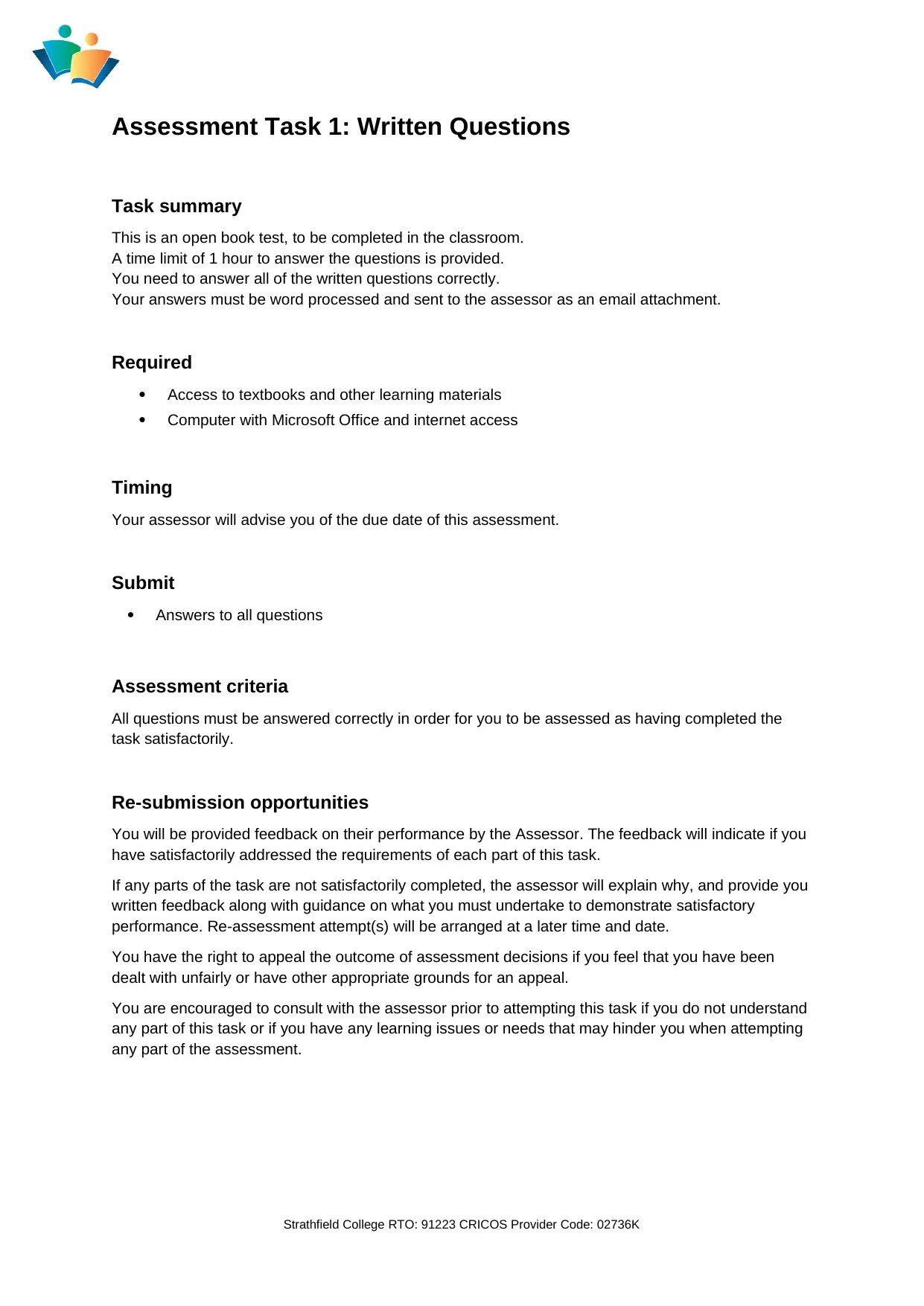
Assessment Task 1: Written Questions
Task summary
This is an open book test, to be completed in the classroom.
A time limit of 1 hour to answer the questions is provided.
You need to answer all of the written questions correctly.
Your answers must be word processed and sent to the assessor as an email attachment.
Required
Access to textbooks and other learning materials
Computer with Microsoft Office and internet access
Timing
Your assessor will advise you of the due date of this assessment.
Submit
Answers to all questions
Assessment criteria
All questions must be answered correctly in order for you to be assessed as having completed the
task satisfactorily.
Re-submission opportunities
You will be provided feedback on their performance by the Assessor. The feedback will indicate if you
have satisfactorily addressed the requirements of each part of this task.
If any parts of the task are not satisfactorily completed, the assessor will explain why, and provide you
written feedback along with guidance on what you must undertake to demonstrate satisfactory
performance. Re-assessment attempt(s) will be arranged at a later time and date.
You have the right to appeal the outcome of assessment decisions if you feel that you have been
dealt with unfairly or have other appropriate grounds for an appeal.
You are encouraged to consult with the assessor prior to attempting this task if you do not understand
any part of this task or if you have any learning issues or needs that may hinder you when attempting
any part of the assessment.
Strathfield College RTO: 91223 CRICOS Provider Code: 02736K
Task summary
This is an open book test, to be completed in the classroom.
A time limit of 1 hour to answer the questions is provided.
You need to answer all of the written questions correctly.
Your answers must be word processed and sent to the assessor as an email attachment.
Required
Access to textbooks and other learning materials
Computer with Microsoft Office and internet access
Timing
Your assessor will advise you of the due date of this assessment.
Submit
Answers to all questions
Assessment criteria
All questions must be answered correctly in order for you to be assessed as having completed the
task satisfactorily.
Re-submission opportunities
You will be provided feedback on their performance by the Assessor. The feedback will indicate if you
have satisfactorily addressed the requirements of each part of this task.
If any parts of the task are not satisfactorily completed, the assessor will explain why, and provide you
written feedback along with guidance on what you must undertake to demonstrate satisfactory
performance. Re-assessment attempt(s) will be arranged at a later time and date.
You have the right to appeal the outcome of assessment decisions if you feel that you have been
dealt with unfairly or have other appropriate grounds for an appeal.
You are encouraged to consult with the assessor prior to attempting this task if you do not understand
any part of this task or if you have any learning issues or needs that may hinder you when attempting
any part of the assessment.
Strathfield College RTO: 91223 CRICOS Provider Code: 02736K
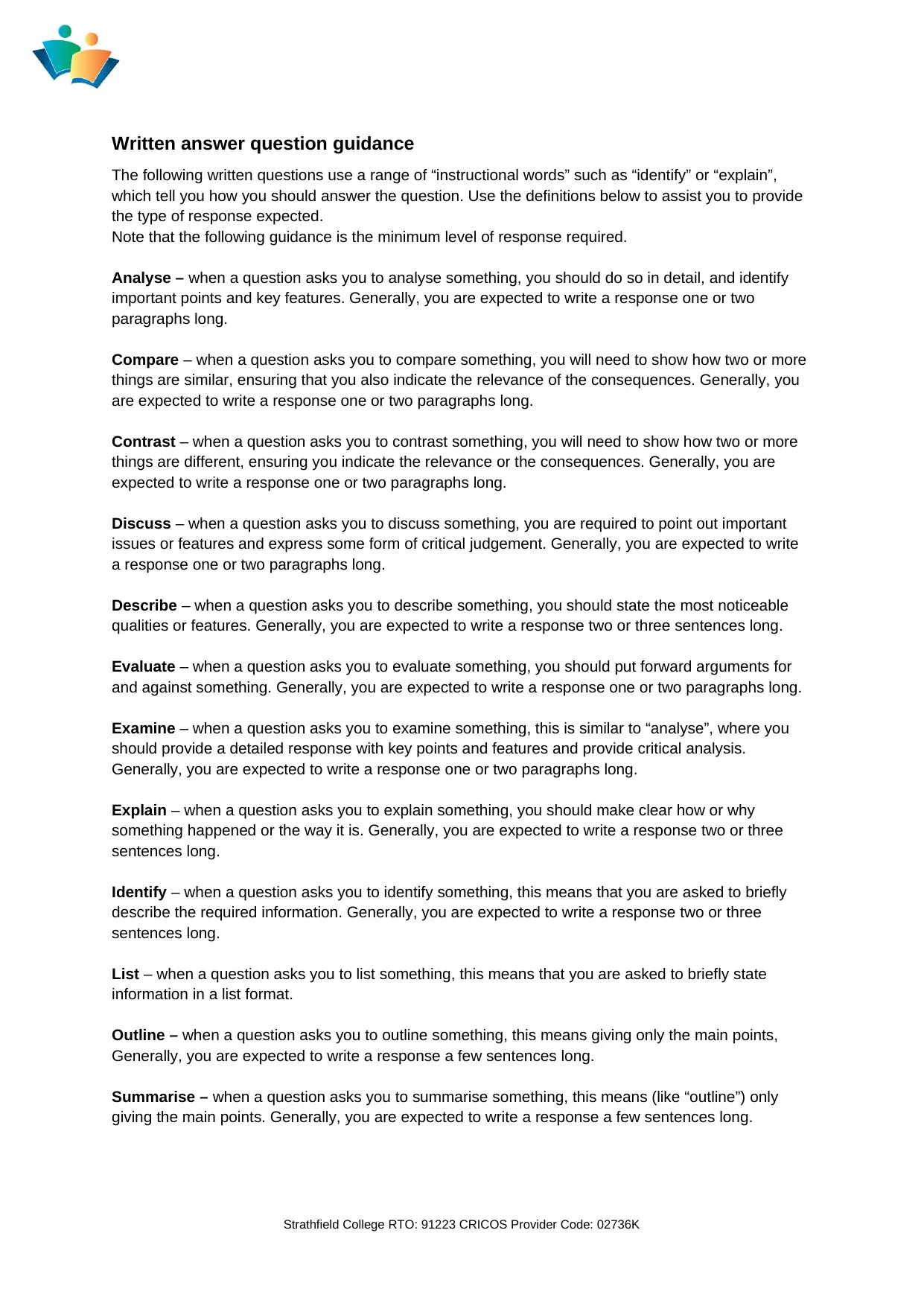
Written answer question guidance
The following written questions use a range of “instructional words” such as “identify” or “explain”,
which tell you how you should answer the question. Use the definitions below to assist you to provide
the type of response expected.
Note that the following guidance is the minimum level of response required.
Analyse – when a question asks you to analyse something, you should do so in detail, and identify
important points and key features. Generally, you are expected to write a response one or two
paragraphs long.
Compare – when a question asks you to compare something, you will need to show how two or more
things are similar, ensuring that you also indicate the relevance of the consequences. Generally, you
are expected to write a response one or two paragraphs long.
Contrast – when a question asks you to contrast something, you will need to show how two or more
things are different, ensuring you indicate the relevance or the consequences. Generally, you are
expected to write a response one or two paragraphs long.
Discuss – when a question asks you to discuss something, you are required to point out important
issues or features and express some form of critical judgement. Generally, you are expected to write
a response one or two paragraphs long.
Describe – when a question asks you to describe something, you should state the most noticeable
qualities or features. Generally, you are expected to write a response two or three sentences long.
Evaluate – when a question asks you to evaluate something, you should put forward arguments for
and against something. Generally, you are expected to write a response one or two paragraphs long.
Examine – when a question asks you to examine something, this is similar to “analyse”, where you
should provide a detailed response with key points and features and provide critical analysis.
Generally, you are expected to write a response one or two paragraphs long.
Explain – when a question asks you to explain something, you should make clear how or why
something happened or the way it is. Generally, you are expected to write a response two or three
sentences long.
Identify – when a question asks you to identify something, this means that you are asked to briefly
describe the required information. Generally, you are expected to write a response two or three
sentences long.
List – when a question asks you to list something, this means that you are asked to briefly state
information in a list format.
Outline – when a question asks you to outline something, this means giving only the main points,
Generally, you are expected to write a response a few sentences long.
Summarise – when a question asks you to summarise something, this means (like “outline”) only
giving the main points. Generally, you are expected to write a response a few sentences long.
Strathfield College RTO: 91223 CRICOS Provider Code: 02736K
The following written questions use a range of “instructional words” such as “identify” or “explain”,
which tell you how you should answer the question. Use the definitions below to assist you to provide
the type of response expected.
Note that the following guidance is the minimum level of response required.
Analyse – when a question asks you to analyse something, you should do so in detail, and identify
important points and key features. Generally, you are expected to write a response one or two
paragraphs long.
Compare – when a question asks you to compare something, you will need to show how two or more
things are similar, ensuring that you also indicate the relevance of the consequences. Generally, you
are expected to write a response one or two paragraphs long.
Contrast – when a question asks you to contrast something, you will need to show how two or more
things are different, ensuring you indicate the relevance or the consequences. Generally, you are
expected to write a response one or two paragraphs long.
Discuss – when a question asks you to discuss something, you are required to point out important
issues or features and express some form of critical judgement. Generally, you are expected to write
a response one or two paragraphs long.
Describe – when a question asks you to describe something, you should state the most noticeable
qualities or features. Generally, you are expected to write a response two or three sentences long.
Evaluate – when a question asks you to evaluate something, you should put forward arguments for
and against something. Generally, you are expected to write a response one or two paragraphs long.
Examine – when a question asks you to examine something, this is similar to “analyse”, where you
should provide a detailed response with key points and features and provide critical analysis.
Generally, you are expected to write a response one or two paragraphs long.
Explain – when a question asks you to explain something, you should make clear how or why
something happened or the way it is. Generally, you are expected to write a response two or three
sentences long.
Identify – when a question asks you to identify something, this means that you are asked to briefly
describe the required information. Generally, you are expected to write a response two or three
sentences long.
List – when a question asks you to list something, this means that you are asked to briefly state
information in a list format.
Outline – when a question asks you to outline something, this means giving only the main points,
Generally, you are expected to write a response a few sentences long.
Summarise – when a question asks you to summarise something, this means (like “outline”) only
giving the main points. Generally, you are expected to write a response a few sentences long.
Strathfield College RTO: 91223 CRICOS Provider Code: 02736K
⊘ This is a preview!⊘
Do you want full access?
Subscribe today to unlock all pages.

Trusted by 1+ million students worldwide
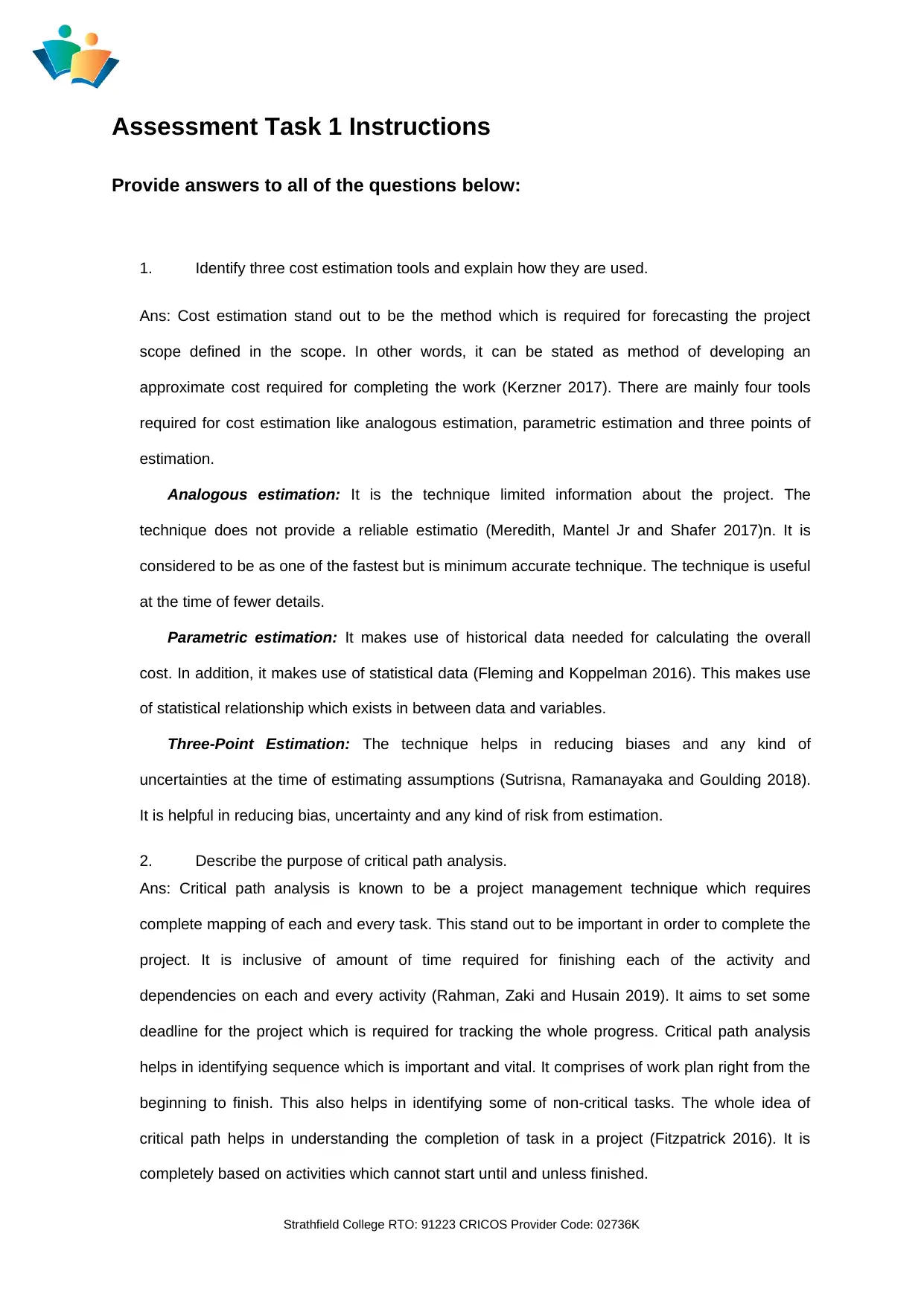
Assessment Task 1 Instructions
Provide answers to all of the questions below:
1. Identify three cost estimation tools and explain how they are used.
Ans: Cost estimation stand out to be the method which is required for forecasting the project
scope defined in the scope. In other words, it can be stated as method of developing an
approximate cost required for completing the work (Kerzner 2017). There are mainly four tools
required for cost estimation like analogous estimation, parametric estimation and three points of
estimation.
Analogous estimation: It is the technique limited information about the project. The
technique does not provide a reliable estimatio (Meredith, Mantel Jr and Shafer 2017)n. It is
considered to be as one of the fastest but is minimum accurate technique. The technique is useful
at the time of fewer details.
Parametric estimation: It makes use of historical data needed for calculating the overall
cost. In addition, it makes use of statistical data (Fleming and Koppelman 2016). This makes use
of statistical relationship which exists in between data and variables.
Three-Point Estimation: The technique helps in reducing biases and any kind of
uncertainties at the time of estimating assumptions (Sutrisna, Ramanayaka and Goulding 2018).
It is helpful in reducing bias, uncertainty and any kind of risk from estimation.
2. Describe the purpose of critical path analysis.
Ans: Critical path analysis is known to be a project management technique which requires
complete mapping of each and every task. This stand out to be important in order to complete the
project. It is inclusive of amount of time required for finishing each of the activity and
dependencies on each and every activity (Rahman, Zaki and Husain 2019). It aims to set some
deadline for the project which is required for tracking the whole progress. Critical path analysis
helps in identifying sequence which is important and vital. It comprises of work plan right from the
beginning to finish. This also helps in identifying some of non-critical tasks. The whole idea of
critical path helps in understanding the completion of task in a project (Fitzpatrick 2016). It is
completely based on activities which cannot start until and unless finished.
Strathfield College RTO: 91223 CRICOS Provider Code: 02736K
Provide answers to all of the questions below:
1. Identify three cost estimation tools and explain how they are used.
Ans: Cost estimation stand out to be the method which is required for forecasting the project
scope defined in the scope. In other words, it can be stated as method of developing an
approximate cost required for completing the work (Kerzner 2017). There are mainly four tools
required for cost estimation like analogous estimation, parametric estimation and three points of
estimation.
Analogous estimation: It is the technique limited information about the project. The
technique does not provide a reliable estimatio (Meredith, Mantel Jr and Shafer 2017)n. It is
considered to be as one of the fastest but is minimum accurate technique. The technique is useful
at the time of fewer details.
Parametric estimation: It makes use of historical data needed for calculating the overall
cost. In addition, it makes use of statistical data (Fleming and Koppelman 2016). This makes use
of statistical relationship which exists in between data and variables.
Three-Point Estimation: The technique helps in reducing biases and any kind of
uncertainties at the time of estimating assumptions (Sutrisna, Ramanayaka and Goulding 2018).
It is helpful in reducing bias, uncertainty and any kind of risk from estimation.
2. Describe the purpose of critical path analysis.
Ans: Critical path analysis is known to be a project management technique which requires
complete mapping of each and every task. This stand out to be important in order to complete the
project. It is inclusive of amount of time required for finishing each of the activity and
dependencies on each and every activity (Rahman, Zaki and Husain 2019). It aims to set some
deadline for the project which is required for tracking the whole progress. Critical path analysis
helps in identifying sequence which is important and vital. It comprises of work plan right from the
beginning to finish. This also helps in identifying some of non-critical tasks. The whole idea of
critical path helps in understanding the completion of task in a project (Fitzpatrick 2016). It is
completely based on activities which cannot start until and unless finished.
Strathfield College RTO: 91223 CRICOS Provider Code: 02736K
Paraphrase This Document
Need a fresh take? Get an instant paraphrase of this document with our AI Paraphraser
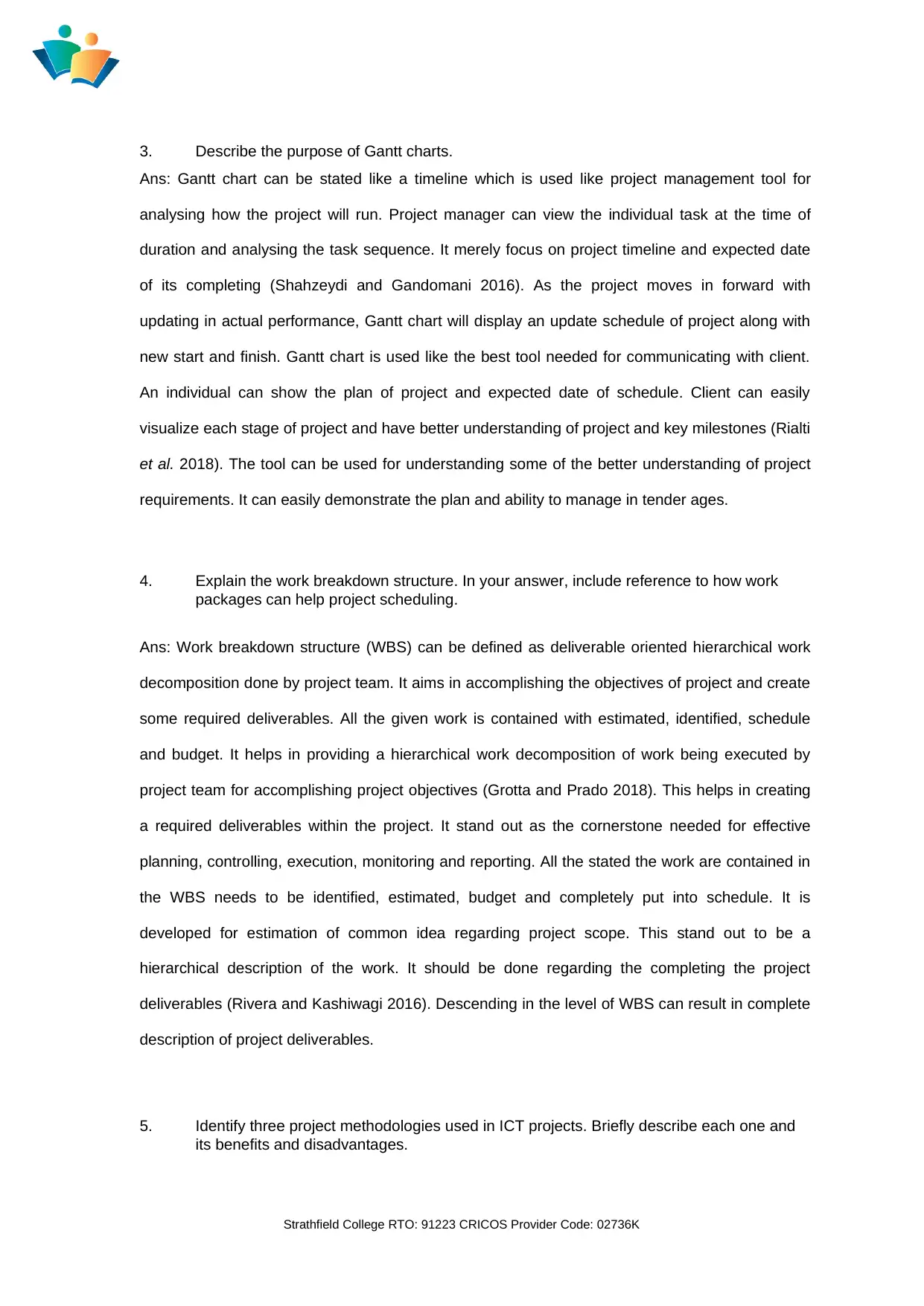
3. Describe the purpose of Gantt charts.
Ans: Gantt chart can be stated like a timeline which is used like project management tool for
analysing how the project will run. Project manager can view the individual task at the time of
duration and analysing the task sequence. It merely focus on project timeline and expected date
of its completing (Shahzeydi and Gandomani 2016). As the project moves in forward with
updating in actual performance, Gantt chart will display an update schedule of project along with
new start and finish. Gantt chart is used like the best tool needed for communicating with client.
An individual can show the plan of project and expected date of schedule. Client can easily
visualize each stage of project and have better understanding of project and key milestones (Rialti
et al. 2018). The tool can be used for understanding some of the better understanding of project
requirements. It can easily demonstrate the plan and ability to manage in tender ages.
4. Explain the work breakdown structure. In your answer, include reference to how work
packages can help project scheduling.
Ans: Work breakdown structure (WBS) can be defined as deliverable oriented hierarchical work
decomposition done by project team. It aims in accomplishing the objectives of project and create
some required deliverables. All the given work is contained with estimated, identified, schedule
and budget. It helps in providing a hierarchical work decomposition of work being executed by
project team for accomplishing project objectives (Grotta and Prado 2018). This helps in creating
a required deliverables within the project. It stand out as the cornerstone needed for effective
planning, controlling, execution, monitoring and reporting. All the stated the work are contained in
the WBS needs to be identified, estimated, budget and completely put into schedule. It is
developed for estimation of common idea regarding project scope. This stand out to be a
hierarchical description of the work. It should be done regarding the completing the project
deliverables (Rivera and Kashiwagi 2016). Descending in the level of WBS can result in complete
description of project deliverables.
5. Identify three project methodologies used in ICT projects. Briefly describe each one and
its benefits and disadvantages.
Strathfield College RTO: 91223 CRICOS Provider Code: 02736K
Ans: Gantt chart can be stated like a timeline which is used like project management tool for
analysing how the project will run. Project manager can view the individual task at the time of
duration and analysing the task sequence. It merely focus on project timeline and expected date
of its completing (Shahzeydi and Gandomani 2016). As the project moves in forward with
updating in actual performance, Gantt chart will display an update schedule of project along with
new start and finish. Gantt chart is used like the best tool needed for communicating with client.
An individual can show the plan of project and expected date of schedule. Client can easily
visualize each stage of project and have better understanding of project and key milestones (Rialti
et al. 2018). The tool can be used for understanding some of the better understanding of project
requirements. It can easily demonstrate the plan and ability to manage in tender ages.
4. Explain the work breakdown structure. In your answer, include reference to how work
packages can help project scheduling.
Ans: Work breakdown structure (WBS) can be defined as deliverable oriented hierarchical work
decomposition done by project team. It aims in accomplishing the objectives of project and create
some required deliverables. All the given work is contained with estimated, identified, schedule
and budget. It helps in providing a hierarchical work decomposition of work being executed by
project team for accomplishing project objectives (Grotta and Prado 2018). This helps in creating
a required deliverables within the project. It stand out as the cornerstone needed for effective
planning, controlling, execution, monitoring and reporting. All the stated the work are contained in
the WBS needs to be identified, estimated, budget and completely put into schedule. It is
developed for estimation of common idea regarding project scope. This stand out to be a
hierarchical description of the work. It should be done regarding the completing the project
deliverables (Rivera and Kashiwagi 2016). Descending in the level of WBS can result in complete
description of project deliverables.
5. Identify three project methodologies used in ICT projects. Briefly describe each one and
its benefits and disadvantages.
Strathfield College RTO: 91223 CRICOS Provider Code: 02736K
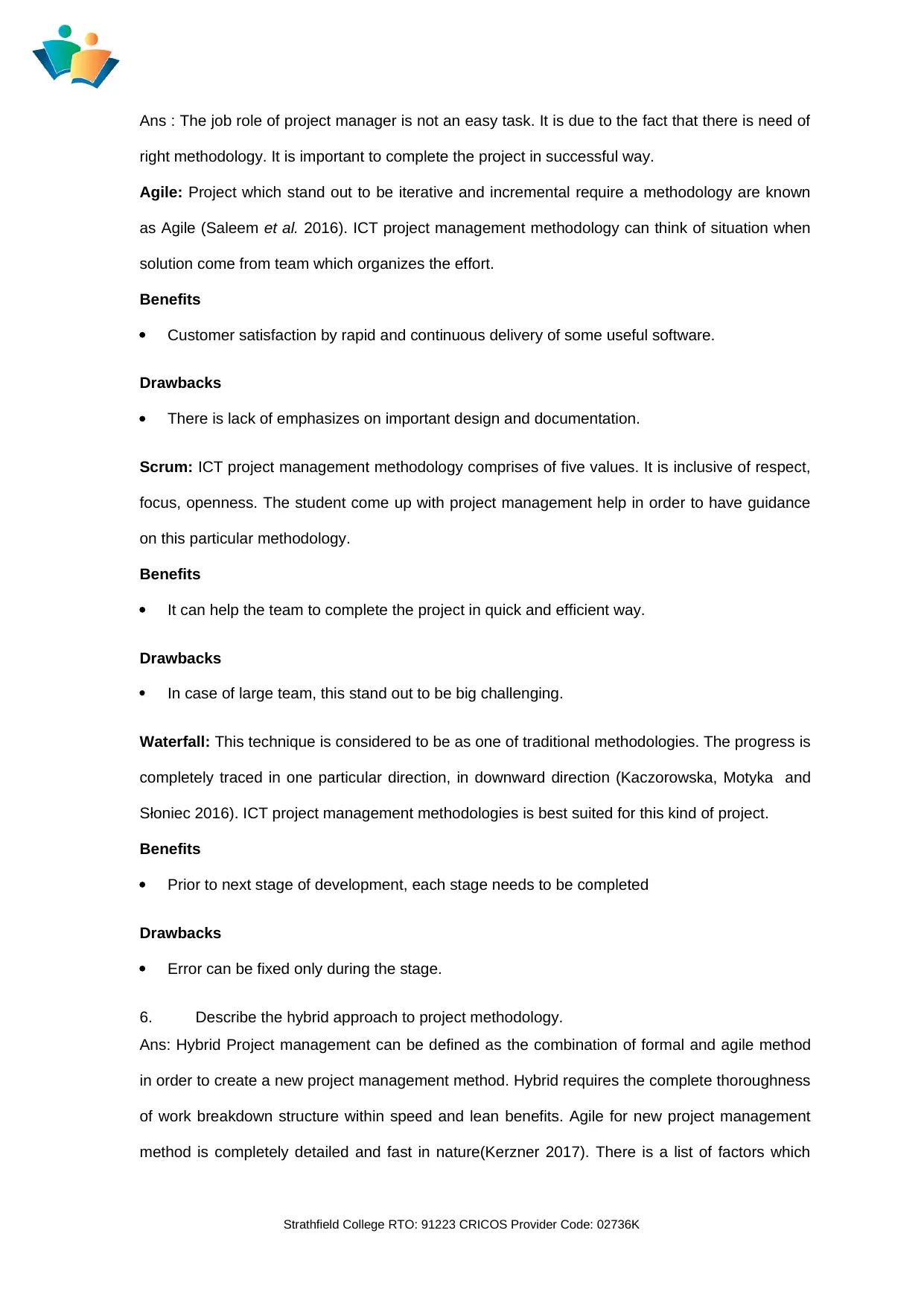
Ans : The job role of project manager is not an easy task. It is due to the fact that there is need of
right methodology. It is important to complete the project in successful way.
Agile: Project which stand out to be iterative and incremental require a methodology are known
as Agile (Saleem et al. 2016). ICT project management methodology can think of situation when
solution come from team which organizes the effort.
Benefits
Customer satisfaction by rapid and continuous delivery of some useful software.
Drawbacks
There is lack of emphasizes on important design and documentation.
Scrum: ICT project management methodology comprises of five values. It is inclusive of respect,
focus, openness. The student come up with project management help in order to have guidance
on this particular methodology.
Benefits
It can help the team to complete the project in quick and efficient way.
Drawbacks
In case of large team, this stand out to be big challenging.
Waterfall: This technique is considered to be as one of traditional methodologies. The progress is
completely traced in one particular direction, in downward direction (Kaczorowska, Motyka and
Słoniec 2016). ICT project management methodologies is best suited for this kind of project.
Benefits
Prior to next stage of development, each stage needs to be completed
Drawbacks
Error can be fixed only during the stage.
6. Describe the hybrid approach to project methodology.
Ans: Hybrid Project management can be defined as the combination of formal and agile method
in order to create a new project management method. Hybrid requires the complete thoroughness
of work breakdown structure within speed and lean benefits. Agile for new project management
method is completely detailed and fast in nature(Kerzner 2017). There is a list of factors which
Strathfield College RTO: 91223 CRICOS Provider Code: 02736K
right methodology. It is important to complete the project in successful way.
Agile: Project which stand out to be iterative and incremental require a methodology are known
as Agile (Saleem et al. 2016). ICT project management methodology can think of situation when
solution come from team which organizes the effort.
Benefits
Customer satisfaction by rapid and continuous delivery of some useful software.
Drawbacks
There is lack of emphasizes on important design and documentation.
Scrum: ICT project management methodology comprises of five values. It is inclusive of respect,
focus, openness. The student come up with project management help in order to have guidance
on this particular methodology.
Benefits
It can help the team to complete the project in quick and efficient way.
Drawbacks
In case of large team, this stand out to be big challenging.
Waterfall: This technique is considered to be as one of traditional methodologies. The progress is
completely traced in one particular direction, in downward direction (Kaczorowska, Motyka and
Słoniec 2016). ICT project management methodologies is best suited for this kind of project.
Benefits
Prior to next stage of development, each stage needs to be completed
Drawbacks
Error can be fixed only during the stage.
6. Describe the hybrid approach to project methodology.
Ans: Hybrid Project management can be defined as the combination of formal and agile method
in order to create a new project management method. Hybrid requires the complete thoroughness
of work breakdown structure within speed and lean benefits. Agile for new project management
method is completely detailed and fast in nature(Kerzner 2017). There is a list of factors which
Strathfield College RTO: 91223 CRICOS Provider Code: 02736K
⊘ This is a preview!⊘
Do you want full access?
Subscribe today to unlock all pages.

Trusted by 1+ million students worldwide
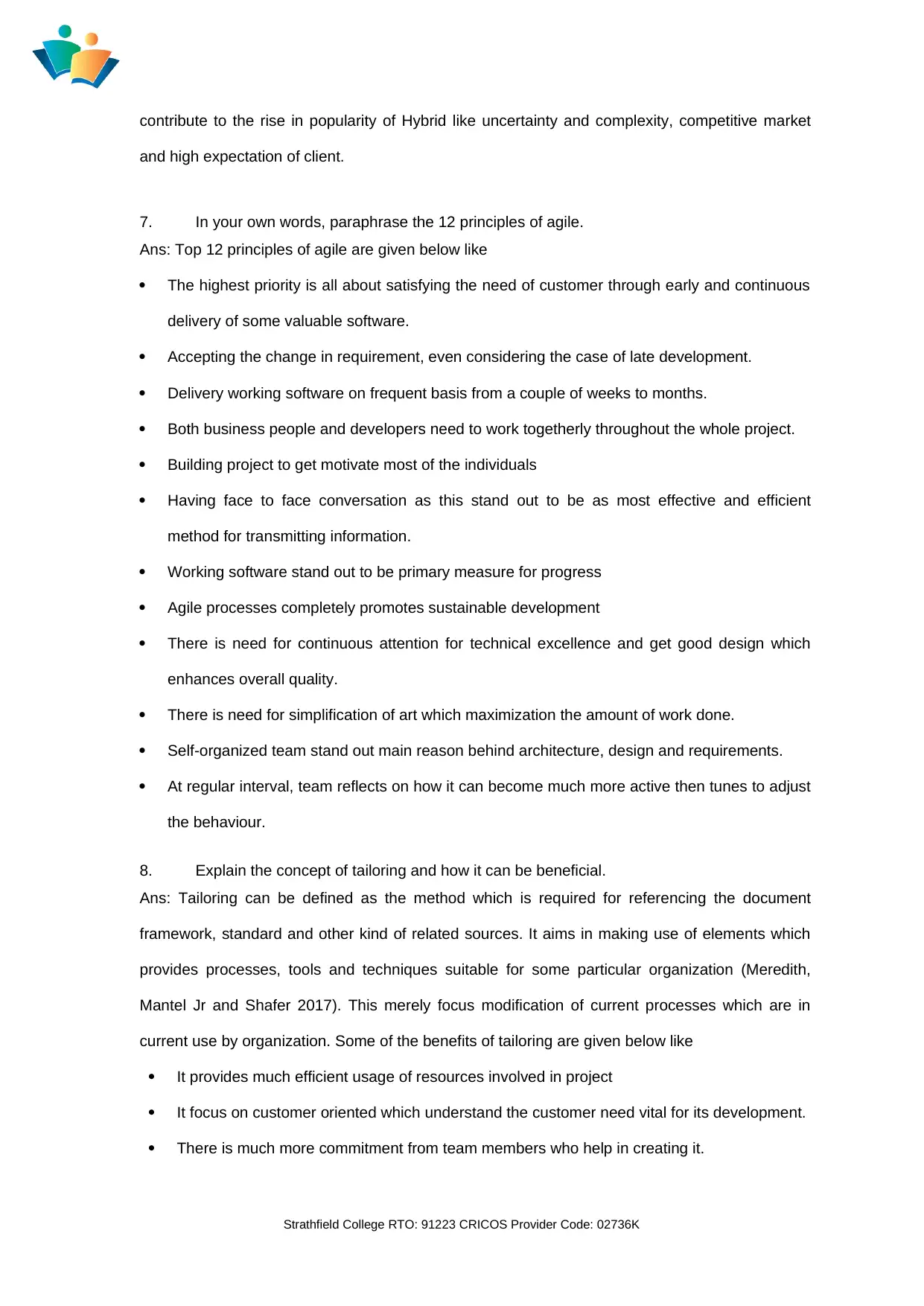
contribute to the rise in popularity of Hybrid like uncertainty and complexity, competitive market
and high expectation of client.
7. In your own words, paraphrase the 12 principles of agile.
Ans: Top 12 principles of agile are given below like
The highest priority is all about satisfying the need of customer through early and continuous
delivery of some valuable software.
Accepting the change in requirement, even considering the case of late development.
Delivery working software on frequent basis from a couple of weeks to months.
Both business people and developers need to work togetherly throughout the whole project.
Building project to get motivate most of the individuals
Having face to face conversation as this stand out to be as most effective and efficient
method for transmitting information.
Working software stand out to be primary measure for progress
Agile processes completely promotes sustainable development
There is need for continuous attention for technical excellence and get good design which
enhances overall quality.
There is need for simplification of art which maximization the amount of work done.
Self-organized team stand out main reason behind architecture, design and requirements.
At regular interval, team reflects on how it can become much more active then tunes to adjust
the behaviour.
8. Explain the concept of tailoring and how it can be beneficial.
Ans: Tailoring can be defined as the method which is required for referencing the document
framework, standard and other kind of related sources. It aims in making use of elements which
provides processes, tools and techniques suitable for some particular organization (Meredith,
Mantel Jr and Shafer 2017). This merely focus modification of current processes which are in
current use by organization. Some of the benefits of tailoring are given below like
It provides much efficient usage of resources involved in project
It focus on customer oriented which understand the customer need vital for its development.
There is much more commitment from team members who help in creating it.
Strathfield College RTO: 91223 CRICOS Provider Code: 02736K
and high expectation of client.
7. In your own words, paraphrase the 12 principles of agile.
Ans: Top 12 principles of agile are given below like
The highest priority is all about satisfying the need of customer through early and continuous
delivery of some valuable software.
Accepting the change in requirement, even considering the case of late development.
Delivery working software on frequent basis from a couple of weeks to months.
Both business people and developers need to work togetherly throughout the whole project.
Building project to get motivate most of the individuals
Having face to face conversation as this stand out to be as most effective and efficient
method for transmitting information.
Working software stand out to be primary measure for progress
Agile processes completely promotes sustainable development
There is need for continuous attention for technical excellence and get good design which
enhances overall quality.
There is need for simplification of art which maximization the amount of work done.
Self-organized team stand out main reason behind architecture, design and requirements.
At regular interval, team reflects on how it can become much more active then tunes to adjust
the behaviour.
8. Explain the concept of tailoring and how it can be beneficial.
Ans: Tailoring can be defined as the method which is required for referencing the document
framework, standard and other kind of related sources. It aims in making use of elements which
provides processes, tools and techniques suitable for some particular organization (Meredith,
Mantel Jr and Shafer 2017). This merely focus modification of current processes which are in
current use by organization. Some of the benefits of tailoring are given below like
It provides much efficient usage of resources involved in project
It focus on customer oriented which understand the customer need vital for its development.
There is much more commitment from team members who help in creating it.
Strathfield College RTO: 91223 CRICOS Provider Code: 02736K
Paraphrase This Document
Need a fresh take? Get an instant paraphrase of this document with our AI Paraphraser
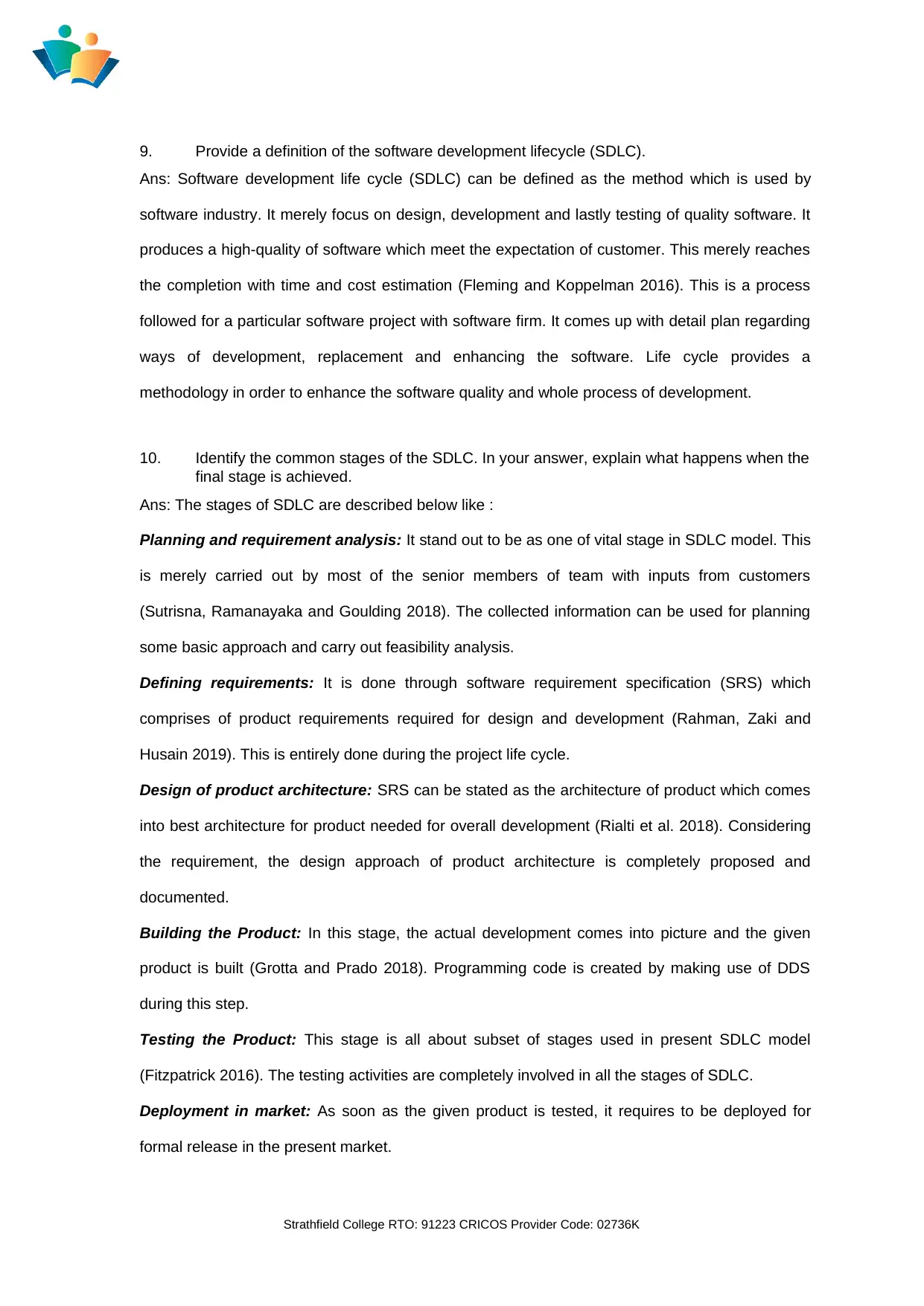
9. Provide a definition of the software development lifecycle (SDLC).
Ans: Software development life cycle (SDLC) can be defined as the method which is used by
software industry. It merely focus on design, development and lastly testing of quality software. It
produces a high-quality of software which meet the expectation of customer. This merely reaches
the completion with time and cost estimation (Fleming and Koppelman 2016). This is a process
followed for a particular software project with software firm. It comes up with detail plan regarding
ways of development, replacement and enhancing the software. Life cycle provides a
methodology in order to enhance the software quality and whole process of development.
10. Identify the common stages of the SDLC. In your answer, explain what happens when the
final stage is achieved.
Ans: The stages of SDLC are described below like :
Planning and requirement analysis: It stand out to be as one of vital stage in SDLC model. This
is merely carried out by most of the senior members of team with inputs from customers
(Sutrisna, Ramanayaka and Goulding 2018). The collected information can be used for planning
some basic approach and carry out feasibility analysis.
Defining requirements: It is done through software requirement specification (SRS) which
comprises of product requirements required for design and development (Rahman, Zaki and
Husain 2019). This is entirely done during the project life cycle.
Design of product architecture: SRS can be stated as the architecture of product which comes
into best architecture for product needed for overall development (Rialti et al. 2018). Considering
the requirement, the design approach of product architecture is completely proposed and
documented.
Building the Product: In this stage, the actual development comes into picture and the given
product is built (Grotta and Prado 2018). Programming code is created by making use of DDS
during this step.
Testing the Product: This stage is all about subset of stages used in present SDLC model
(Fitzpatrick 2016). The testing activities are completely involved in all the stages of SDLC.
Deployment in market: As soon as the given product is tested, it requires to be deployed for
formal release in the present market.
Strathfield College RTO: 91223 CRICOS Provider Code: 02736K
Ans: Software development life cycle (SDLC) can be defined as the method which is used by
software industry. It merely focus on design, development and lastly testing of quality software. It
produces a high-quality of software which meet the expectation of customer. This merely reaches
the completion with time and cost estimation (Fleming and Koppelman 2016). This is a process
followed for a particular software project with software firm. It comes up with detail plan regarding
ways of development, replacement and enhancing the software. Life cycle provides a
methodology in order to enhance the software quality and whole process of development.
10. Identify the common stages of the SDLC. In your answer, explain what happens when the
final stage is achieved.
Ans: The stages of SDLC are described below like :
Planning and requirement analysis: It stand out to be as one of vital stage in SDLC model. This
is merely carried out by most of the senior members of team with inputs from customers
(Sutrisna, Ramanayaka and Goulding 2018). The collected information can be used for planning
some basic approach and carry out feasibility analysis.
Defining requirements: It is done through software requirement specification (SRS) which
comprises of product requirements required for design and development (Rahman, Zaki and
Husain 2019). This is entirely done during the project life cycle.
Design of product architecture: SRS can be stated as the architecture of product which comes
into best architecture for product needed for overall development (Rialti et al. 2018). Considering
the requirement, the design approach of product architecture is completely proposed and
documented.
Building the Product: In this stage, the actual development comes into picture and the given
product is built (Grotta and Prado 2018). Programming code is created by making use of DDS
during this step.
Testing the Product: This stage is all about subset of stages used in present SDLC model
(Fitzpatrick 2016). The testing activities are completely involved in all the stages of SDLC.
Deployment in market: As soon as the given product is tested, it requires to be deployed for
formal release in the present market.
Strathfield College RTO: 91223 CRICOS Provider Code: 02736K
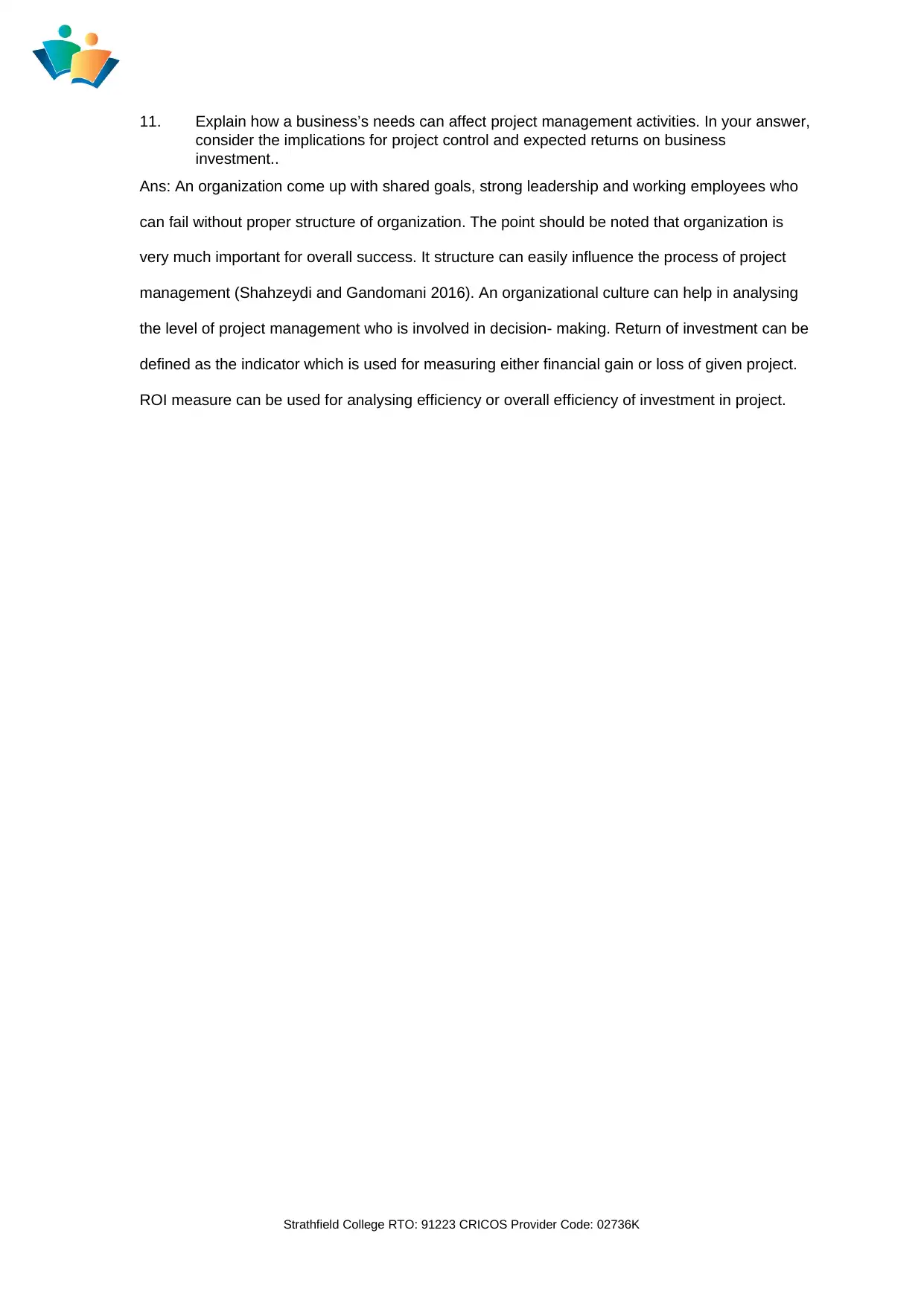
11. Explain how a business’s needs can affect project management activities. In your answer,
consider the implications for project control and expected returns on business
investment..
Ans: An organization come up with shared goals, strong leadership and working employees who
can fail without proper structure of organization. The point should be noted that organization is
very much important for overall success. It structure can easily influence the process of project
management (Shahzeydi and Gandomani 2016). An organizational culture can help in analysing
the level of project management who is involved in decision- making. Return of investment can be
defined as the indicator which is used for measuring either financial gain or loss of given project.
ROI measure can be used for analysing efficiency or overall efficiency of investment in project.
Strathfield College RTO: 91223 CRICOS Provider Code: 02736K
consider the implications for project control and expected returns on business
investment..
Ans: An organization come up with shared goals, strong leadership and working employees who
can fail without proper structure of organization. The point should be noted that organization is
very much important for overall success. It structure can easily influence the process of project
management (Shahzeydi and Gandomani 2016). An organizational culture can help in analysing
the level of project management who is involved in decision- making. Return of investment can be
defined as the indicator which is used for measuring either financial gain or loss of given project.
ROI measure can be used for analysing efficiency or overall efficiency of investment in project.
Strathfield College RTO: 91223 CRICOS Provider Code: 02736K
⊘ This is a preview!⊘
Do you want full access?
Subscribe today to unlock all pages.

Trusted by 1+ million students worldwide
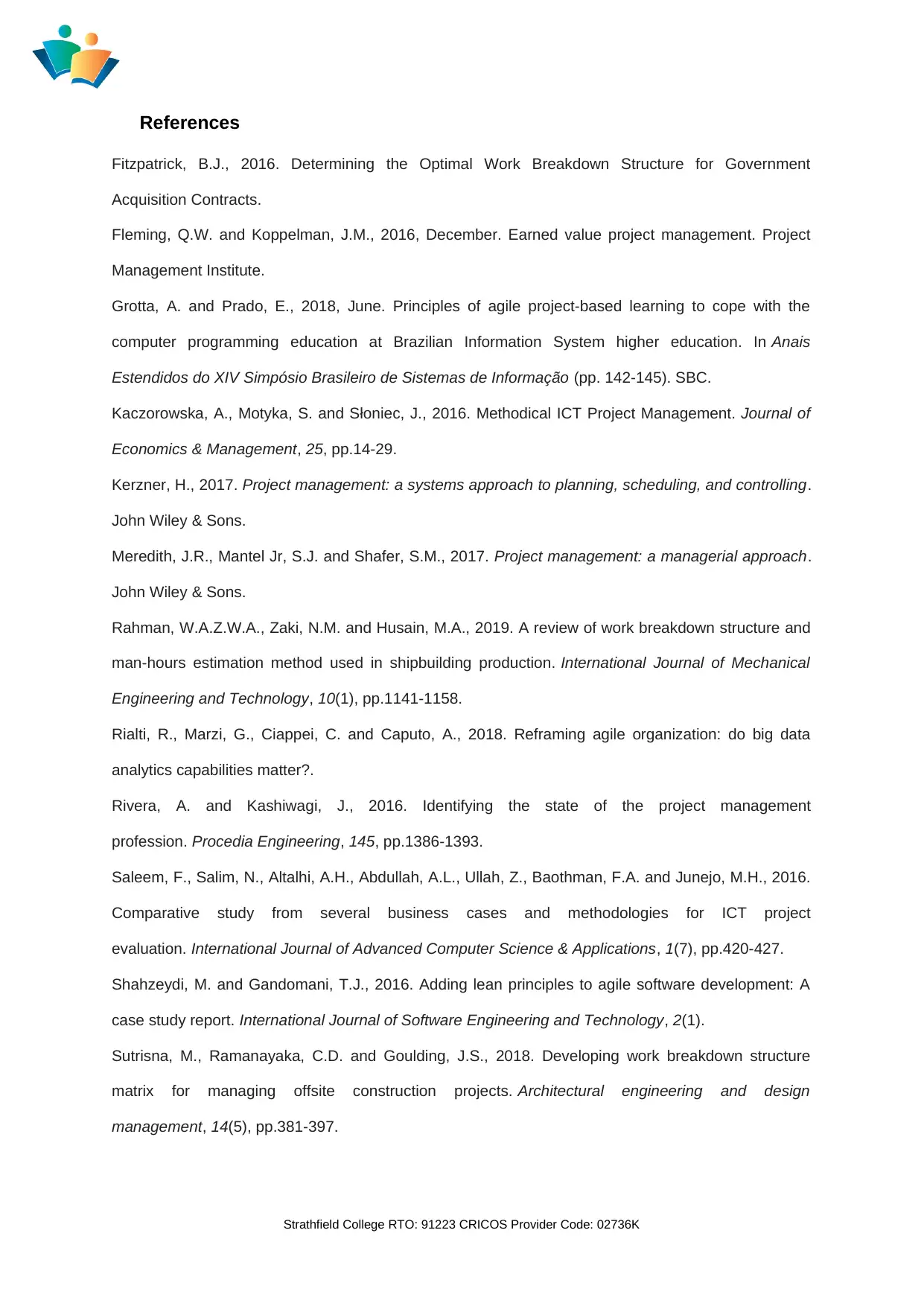
References
Fitzpatrick, B.J., 2016. Determining the Optimal Work Breakdown Structure for Government
Acquisition Contracts.
Fleming, Q.W. and Koppelman, J.M., 2016, December. Earned value project management. Project
Management Institute.
Grotta, A. and Prado, E., 2018, June. Principles of agile project-based learning to cope with the
computer programming education at Brazilian Information System higher education. In Anais
Estendidos do XIV Simpósio Brasileiro de Sistemas de Informação (pp. 142-145). SBC.
Kaczorowska, A., Motyka, S. and Słoniec, J., 2016. Methodical ICT Project Management. Journal of
Economics & Management, 25, pp.14-29.
Kerzner, H., 2017. Project management: a systems approach to planning, scheduling, and controlling.
John Wiley & Sons.
Meredith, J.R., Mantel Jr, S.J. and Shafer, S.M., 2017. Project management: a managerial approach.
John Wiley & Sons.
Rahman, W.A.Z.W.A., Zaki, N.M. and Husain, M.A., 2019. A review of work breakdown structure and
man-hours estimation method used in shipbuilding production. International Journal of Mechanical
Engineering and Technology, 10(1), pp.1141-1158.
Rialti, R., Marzi, G., Ciappei, C. and Caputo, A., 2018. Reframing agile organization: do big data
analytics capabilities matter?.
Rivera, A. and Kashiwagi, J., 2016. Identifying the state of the project management
profession. Procedia Engineering, 145, pp.1386-1393.
Saleem, F., Salim, N., Altalhi, A.H., Abdullah, A.L., Ullah, Z., Baothman, F.A. and Junejo, M.H., 2016.
Comparative study from several business cases and methodologies for ICT project
evaluation. International Journal of Advanced Computer Science & Applications, 1(7), pp.420-427.
Shahzeydi, M. and Gandomani, T.J., 2016. Adding lean principles to agile software development: A
case study report. International Journal of Software Engineering and Technology, 2(1).
Sutrisna, M., Ramanayaka, C.D. and Goulding, J.S., 2018. Developing work breakdown structure
matrix for managing offsite construction projects. Architectural engineering and design
management, 14(5), pp.381-397.
Strathfield College RTO: 91223 CRICOS Provider Code: 02736K
Fitzpatrick, B.J., 2016. Determining the Optimal Work Breakdown Structure for Government
Acquisition Contracts.
Fleming, Q.W. and Koppelman, J.M., 2016, December. Earned value project management. Project
Management Institute.
Grotta, A. and Prado, E., 2018, June. Principles of agile project-based learning to cope with the
computer programming education at Brazilian Information System higher education. In Anais
Estendidos do XIV Simpósio Brasileiro de Sistemas de Informação (pp. 142-145). SBC.
Kaczorowska, A., Motyka, S. and Słoniec, J., 2016. Methodical ICT Project Management. Journal of
Economics & Management, 25, pp.14-29.
Kerzner, H., 2017. Project management: a systems approach to planning, scheduling, and controlling.
John Wiley & Sons.
Meredith, J.R., Mantel Jr, S.J. and Shafer, S.M., 2017. Project management: a managerial approach.
John Wiley & Sons.
Rahman, W.A.Z.W.A., Zaki, N.M. and Husain, M.A., 2019. A review of work breakdown structure and
man-hours estimation method used in shipbuilding production. International Journal of Mechanical
Engineering and Technology, 10(1), pp.1141-1158.
Rialti, R., Marzi, G., Ciappei, C. and Caputo, A., 2018. Reframing agile organization: do big data
analytics capabilities matter?.
Rivera, A. and Kashiwagi, J., 2016. Identifying the state of the project management
profession. Procedia Engineering, 145, pp.1386-1393.
Saleem, F., Salim, N., Altalhi, A.H., Abdullah, A.L., Ullah, Z., Baothman, F.A. and Junejo, M.H., 2016.
Comparative study from several business cases and methodologies for ICT project
evaluation. International Journal of Advanced Computer Science & Applications, 1(7), pp.420-427.
Shahzeydi, M. and Gandomani, T.J., 2016. Adding lean principles to agile software development: A
case study report. International Journal of Software Engineering and Technology, 2(1).
Sutrisna, M., Ramanayaka, C.D. and Goulding, J.S., 2018. Developing work breakdown structure
matrix for managing offsite construction projects. Architectural engineering and design
management, 14(5), pp.381-397.
Strathfield College RTO: 91223 CRICOS Provider Code: 02736K
Paraphrase This Document
Need a fresh take? Get an instant paraphrase of this document with our AI Paraphraser
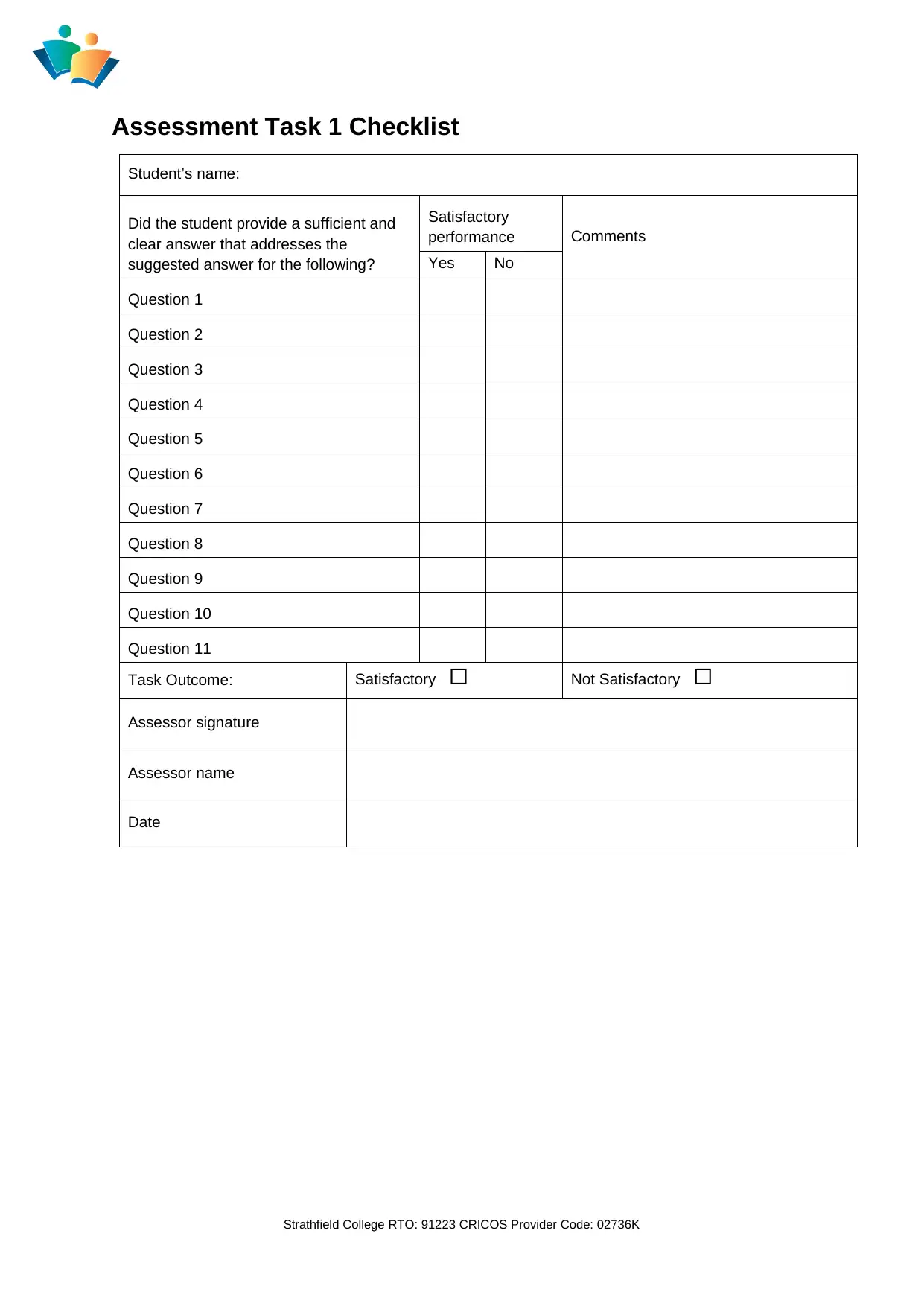
Assessment Task 1 Checklist
Student’s name:
Did the student provide a sufficient and
clear answer that addresses the
suggested answer for the following?
Satisfactory
performance Comments
Yes No
Question 1
Question 2
Question 3
Question 4
Question 5
Question 6
Question 7
Question 8
Question 9
Question 10
Question 11
Task Outcome: Satisfactory Not Satisfactory
Assessor signature
Assessor name
Date
Strathfield College RTO: 91223 CRICOS Provider Code: 02736K
Student’s name:
Did the student provide a sufficient and
clear answer that addresses the
suggested answer for the following?
Satisfactory
performance Comments
Yes No
Question 1
Question 2
Question 3
Question 4
Question 5
Question 6
Question 7
Question 8
Question 9
Question 10
Question 11
Task Outcome: Satisfactory Not Satisfactory
Assessor signature
Assessor name
Date
Strathfield College RTO: 91223 CRICOS Provider Code: 02736K
1 out of 11
Related Documents
Your All-in-One AI-Powered Toolkit for Academic Success.
+13062052269
info@desklib.com
Available 24*7 on WhatsApp / Email
![[object Object]](/_next/static/media/star-bottom.7253800d.svg)
Unlock your academic potential
Copyright © 2020–2025 A2Z Services. All Rights Reserved. Developed and managed by ZUCOL.





